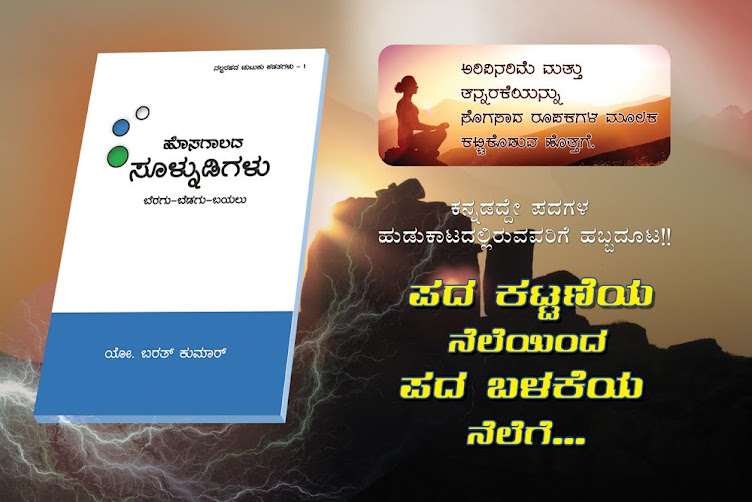ಇತ್ತೀಚಿನ ಕನ್ನಡ-ಇಂಗ್ಲಿಷ್ ಕಲಿಕೆಯ ಬಗ್ಗೆ ಚರ್ಚೆಗಳು ನಡೆಯುತ್ತಿರುವಾಗಲೆ ನನ್ನ ತಲೆಯಲ್ಲಿ ಎರಡು ಭಾಷೆಗಳ ಕಲಿಕೆಯ ಬಗ್ಗೆ ಕೆಲವು ವಿಚಾರಗಳು ಹಾದು ಹೋದವು. ಹುಟ್ಟಿದ ಕೆಲವು ದಿನಗಳ ನಂತರ ಮಗುವು ತನ್ನಿಂತಾನೆ ಉಚ್ಚಾರ ಮಾಡುವ ಮೊದಲ ಅಕ್ಷರ "ಅ" ಹಾಗು ಕನ್ನಡದ ಅಕ್ಷರಮಾಲೆಯಲ್ಲಿರುವ ಮೊದಲ ಅಕ್ಷರ ಕೂಡ "ಅ". ಇದರಿಂದ ಕನ್ನಡ ಭಾಷೆ ಮಗುವಿಗೆ ತುಂಬ ಸ್ವಾಭಾವಿಕವಾಗಿದೆ. ವಿದ್ಯಾಭ್ಯಾಸ ಪ್ರಾರಂಭವಾದ ಮೇಲೆ ಮಕ್ಕಳು ಮೊದಲುಸ್ವರಾಕ್ಷರಗಳ ಉಚ್ಚಾರ ಕಲಿಯುವುದರಿಂದ ಹಾಗು ಅವುಗಳ ಉಚ್ಚಾರ ಸರಳ-ಸುಲಭವಾಗಿರುವುದರಿಂದ, ಕನ್ನಡ ಮೊದಲು ಕಲಿಯಲು ಬಹಳ ಅನುಕೂಲಕರ ಹಾಗು ಮಕ್ಕಳ ಕಲಿಕೆಯ ಕ್ರಮಕ್ಕೆ ಪೂರಕ.
* ಮಕ್ಕಳು ಕನ್ನಡದಲ್ಲಿ ಮೊದಲು ಸ್ವರಾಕ್ಷಾರಗಳನ್ನು ಕಲಿಯುವುದು ನಂತರ ವ್ಯಂಜನ ತದನಂತರ ಅವರ್ಗೀಯ ವ್ಯಂಜನ, ಹಾಗಾಗಿ ಕಲಿಯುವ ಅಕ್ಷರಗಳ ಈ ಸರಣಿ ಸರಳ ಹಾಗು ಸುಲಭ ಉಚ್ಚಾರಣೆಯಿಂದ ಮೊದಲ್ಗೊಂಡು ಕಷ್ಟ ಉಚ್ಚಾರವಾಗುತ್ತ ಹೋಗುತ್ತದೆ.
* ಮೊದಲು ಸುಲಭ ಉಚ್ಚಾರ ಮಾಡಬಹುದಾದ ಸ್ವರಗಳು( ಅ, ಆ, ಇ, ಈ, ಉ, ಊ, ಋ, ೠ, ಎ, ಏ, ಐ, ಒ, ಓ, ಔ, ಅಂ, ಅಃ). ನಂತರ ಕಷ್ಟವಾದಂತಹ 'ಕ' ವರ್ಗ, 'ಚ' ವರ್ಗ, 'ಟ' ವರ್ಗ, 'ತ' ವರ್ಗ, 'ಪ' ವರ್ಗ ನಂತರ ಅವರ್ಗೀಯ ವ್ಯಂಜನ( ಯ, ರ, ಲ, ವ, ಶ, ಸ, ಹ, ಳ)
* ಇಲ್ಲಿ ನಾವು ಸೂಕ್ಷ್ಮವಾಗಿ ಗಮನಿಸಿದರೆ ಒಂದು ವರ್ಗದ ಅಕ್ಷರಗಳ ಉಚ್ಚಾರದ ಅಂತರ ಬಹಳ ಕಡಿಮೆ ಇದೆ. ಉದಾ: 'ಕ' ಮತ್ತು 'ಖ' ಎರಡು 'ಕ' ವರ್ಗಕ್ಕೆ ಸೇರಿವೆ. ಆದರೆ ಇವುಗಳ ಉಚ್ಚಾರದಲ್ಲಿರುವ ಅಂತರ ಕೇವಲ ಉಸಿರಿಗೆ ಒತ್ತು ಕೊಡುವುದು.
* 'ಕ' ವರ್ಗದ ಅಕ್ಷರಗಳು ಉಚ್ಚಾರಣೆಯ ದೃಷ್ಟಿಯಿಂದ 'ಚ' ವರ್ಗಕ್ಕಿಂತ ಸುಲಭವಾಗಿವೆ.
* ಙ, ಞ - ಈ ಅಕ್ಷರಗಳ ಉಚ್ಚಾರಣೆ ಕಠಿಣವಾಗಿದೆಯಾದರೂ ಇವು ಮೊದಲು ಕಲಿಯುವ ಪದಗಳಲ್ಲಿ ಬರುವುದಿಲ್ಲ( ಉದಾ: ಅರಸ, ಆಡು, ಇಲಿ, ಈಶ)
ಆದರೆ ಇಂಗ್ಲೀಷ್ ನಲ್ಲಿ ಮೊದಲು ಕಲಿಯುವ ಅಕ್ಷರಗಳ ಬಗ್ಗೆ ಗಮನಿಸೋಣ
ಎ, ಬಿ, ಸಿ, ಡಿ, ಇ, ಎಫ್, ಜಿ, ಹೆಚ್, ಐ, ಜೆ, ಕೆ, ಎಲ್, ಎಮ್, ಎನ್, ಒ, ಪಿ, ಕ್ಯು, ಆರ್, ಎಸ್, ಟಿ, ಯು, ವಿ, ಡಬ್ಲು, ಎಕ್ಸ್, ವೈ, ಜೆಡ್.
A, B, C, D, E, F, G, H, I, J, K, L, M, N, O, P, Q, R, S, T, U, V, W, X, Y, Z
ಈ ಅಕ್ಷರಗಳ ಸರಣಿಯಲ್ಲಿ ಬರುವ ಅಕ್ಶರಗಳ ಉಚ್ಚಾರಣೆ ಒಂದಕ್ಕಿಂತ ಒಂದು ಭಿನ್ನವಾಗಿವೆ. ಉದಾ: ಬಿ ಮತ್ತು ಸಿ ಅಕ್ಕ-ಪಕ್ಕದ ಪದಗಳು ಮತ್ತು ಇಂಗ್ಲೀಷ್ ನಲ್ಲಿಕಲಿಯುವ ೨ ಮತ್ತು ೩ ನೇ ಅಕ್ಷರ , 'ಬಿ' ಯನ್ನು ಉಚ್ಚರಿಸಲು ತುಟಿಗಳನ್ನು ಉಪಯೋಗಿಸಬೇಕು ಆದರೆ 'ಸಿ' ಯನ್ನು ಉಚ್ಚರಿಸಲು ನಾಲಿಗೆಯನ್ನು, ಆದರೆ ಕನ್ನಡದಲ್ಲಿರುವ ೨ ಮತ್ತು ೩ನೇ ಅಕ್ಷರಗಳು ಆ, ಇ ಇವೆರಡು ಗಂಟಲಿಂದಲೆ(ಅಥವಾ ಧ್ವನಿಪೆಟ್ಟಿಗೆ) ಉಚ್ಚಾರವಾಗುವ ಅಕ್ಶರಗಳು. ಮಕ್ಕಳನ್ನು ಸೂಕ್ಷ್ಮವಾಗಿ ಗಮನಿಸಿದರೆ ಅವರು ಗಂಟಲಿನಿಂದಉಚ್ಚರಿಸುವ ಅಕ್ಷರಗಳನ್ನು ಮೊದಲು ಮತ್ತು ವೇಗವಾಗಿ ಕಲಿಯುತ್ತಾರೆ. ಮಕ್ಕಳು ನಾಲಿಗೆ ಅಥವಾ ತುಟಿಗಳಿಂದ ಬರುವ ಅಕ್ಷರಗಳನ್ನು( ಉದಾ: ಚ, ರ, ಶ) ನಿಧಾನವಾಗಿ ಕಲಿಯುತ್ತಾರೆ, ಹೀಗಾಗಿ ಇಂಗ್ಲೀಷ ಅಕ್ಷರಗಳ ಸರಣಿ ಮಕ್ಕಳ ಕಲಿಕೆಯ ದೃಷ್ಟಿಯಿಂದ ಸ್ವಾಭಾವಿಕ ಮತ್ತು ಪೂರಕವಾಗಿಲ್ಲ.
ಕನ್ನಡದಲ್ಲಿ ಕಲಿಕಾ ಕ್ರಮ ಹೀಗಿದೆ :-
೧) ಅಕ್ಷರಮಾಲೆಗಳ ಉಚ್ಚಾರ ಮತ್ತು ಬರವಣಿಗೆ
೨) ಕಾಗುಣಿತ ಉಚ್ಚಾರ ಮತ್ತು ಬರವಣಿಗೆ
೩) ಅಕ್ಷರಗಳ ಜೋಡಣೆ ಅಥವ ಪದಗಳ ಉಚ್ಚಾರ ಮತ್ತು ಬರವಣಿಗೆ
ಇಂಗ್ಲೀಷ ಕಲಿಕಾ ಕ್ರಮ ಹೀಗಿದೆ : -
೧) ಅಕ್ಷರಮಾಲೆಗಳ ಉಚ್ಚಾರ ಮತ್ತು ಬರವಣಿಗೆ
೨) ಅಕ್ಷರಗಳ ಜೋಡಣೆ ಅಥವ ಪದಗಳ ಉಚ್ಚಾರ ಮತ್ತು ಬರವಣಿಗೆ
ಇಲ್ಲಿ ನಾವು ಗಮನಿಸಬೇಕಾದುದೇನೆಂದರೆ ಇಂಗ್ಲೀಷಿನಲ್ಲಿ "ಕಾಗುಣಿತ"ವೆಂಬ ಕಲಿಕಾ ಕ್ರಮವೇ ಇಲ್ಲ. ಇದು ಇಂಗ್ಲೀಷ ಕಲಿಕೆಯ ಕ್ರಮದಲ್ಲಿರುವ ಮುಖ್ಯವಾದ ಋಣಾತ್ಮಕ ಅಂಶ.ಪದಗಳ ಜೋಡಣೆ ಗಮನಿಸಿದರೆ ಸಿ(C) ಯು(U) ಟಿ(T) -> ಕಟ್(CUT) ಆಗುತ್ತದೆ. ಪಿ(P) ಯು(U) ಟಿ(T) -> ಪುಟ್(PUT) ಆಗುತ್ತದೆ. ಹಾಗಾಗಿ ಪದಗಳ ಜೋಡಣೆಯಲ್ಲಿ ಯಾವುದೆ (ಕಾಗುಣಿತದ) ನಿಯಮಗಳ ಪಾಲನೆಯಿಲ್ಲ ಅಂದರೆ ಯಾವುದೆ ವೈಙ್ನಾನಿಕವಾದ ವ್ಯವಸ್ಥೆಯಿಲ್ಲ. ಆದ್ದರಿಂದ ಇಂಗ್ಲೀಷ ಚಿಕ್ಕ ಮಕ್ಕಳ ಕಲಿಕೆಗೆ ಯೋಗ್ಯವಾದ ಭಾಷೆಯಾಗಿಲ್ಲ. ಕನ್ನಡ ತಕ್ಕಮಟ್ಟಿಗೆ ಕಲಿತ ನಂತರ ಇಂಗ್ಲೀಷ್ ಕಲಿಯುವುದು ಬಹಳ ಸೂಕ್ತವಾಗಿದೆ.









